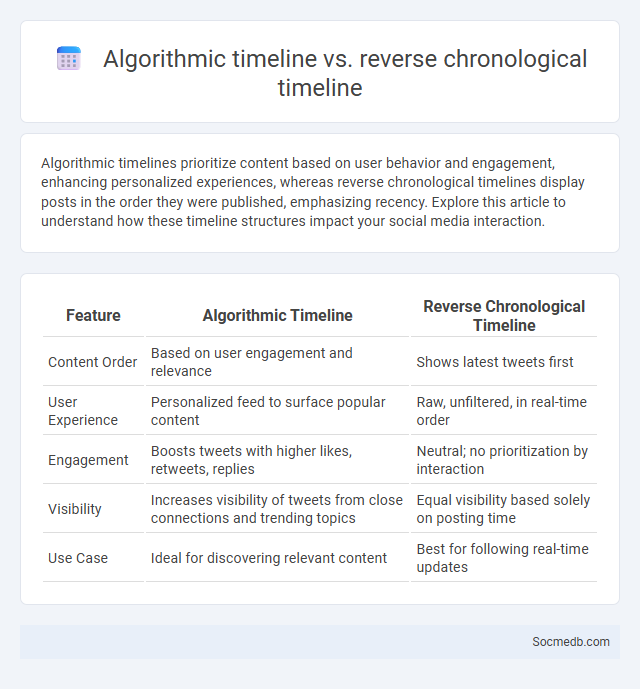
Photo illustration: Algorithmic timeline vs Reverse chronological timeline
Algorithmic timelines prioritize content based on user behavior and engagement, enhancing personalized experiences, whereas reverse chronological timelines display posts in the order they were published, emphasizing recency. Explore this article to understand how these timeline structures impact your social media interaction.
Table of Comparison
| Feature | Algorithmic Timeline | Reverse Chronological Timeline |
|---|---|---|
| Content Order | Based on user engagement and relevance | Shows latest tweets first |
| User Experience | Personalized feed to surface popular content | Raw, unfiltered, in real-time order |
| Engagement | Boosts tweets with higher likes, retweets, replies | Neutral; no prioritization by interaction |
| Visibility | Increases visibility of tweets from close connections and trending topics | Equal visibility based solely on posting time |
| Use Case | Ideal for discovering relevant content | Best for following real-time updates |
Introduction to Social Media Timelines
Social media timelines organize content chronologically to provide users with real-time updates and a personalized feed experience. Platforms like Twitter, Facebook, and Instagram use algorithms to prioritize posts based on relevance, engagement, and user interaction patterns. Understanding how your timeline operates helps optimize content visibility and enhances your social media engagement strategy.
What is a Reverse Chronological Timeline?
A reverse chronological timeline on social media displays posts and updates starting with the most recent first, allowing users to see the latest content immediately. This format enhances user engagement by prioritizing current events and timely information over older posts. Platforms like Twitter and Instagram have utilized reverse chronological timelines to keep feeds fresh and relevant, ensuring real-time interaction and discovery.
Defining Algorithmic Timelines
Algorithmic timelines prioritize content based on relevance, engagement, and user behavior, ensuring your feed displays posts tailored to your interests. These algorithms analyze data such as interactions, post type, and timing to rank updates in a personalized order rather than chronological sequence. Understanding how algorithmic timelines function helps you optimize your social media strategy for greater visibility and connection.
Key Differences Between Algorithmic and Reverse Chronological Timelines
Algorithmic timelines prioritize content based on user engagement metrics, such as likes, comments, and shares, tailoring posts to individual preferences and increasing relevance. Reverse chronological timelines display posts strictly according to the time of publication, ensuring the most recent updates appear first without prioritization. The algorithmic approach enhances personalized content consumption, while reverse chronological offers a straightforward, time-based content stream.
Benefits of Reverse Chronological Timelines
Reverse chronological timelines on social media enhance user experience by presenting the most recent posts first, ensuring timely updates and real-time engagement. This format improves content discoverability, as fresh posts gain immediate visibility, increasing interaction rates and platform activity. Brands and influencers benefit from this structure by effectively capturing audience attention during peak relevance periods.
Advantages of Algorithmic Timelines
Algorithmic timelines on social media enhance user experience by curating personalized content based on individual preferences, increasing engagement and satisfaction. These timelines prioritize relevant posts, reducing information overload and helping users discover meaningful connections and trends efficiently. Brands benefit from targeted exposure, improving advertising effectiveness and fostering stronger audience relationships.
User Engagement: Algorithmic vs Reverse Chronological
User engagement on social media is heavily influenced by the feed algorithm, which prioritizes content based on your interactions, interests, and relevance, enhancing personalized experiences to keep you connected. The reverse chronological feed, on the other hand, displays posts in the order they were published, promoting real-time updates but potentially reducing engagement by showing less relevant content. Understanding the impact of algorithmic sorting versus reverse chronological timelines helps optimize how you interact and maximize visibility on platforms like Instagram, Twitter, and Facebook.
Impact on Content Discovery
Social media platforms revolutionize content discovery by leveraging sophisticated algorithms that personalize user feeds based on interests and behaviors, enhancing user engagement and content relevance. Trending hashtags, shares, and influencer endorsements amplify visibility, enabling niche topics and emerging creators to reach broader audiences swiftly. The dynamic interaction between user-generated content and platform recommendations fosters a continuously evolving ecosystem where content discovery is more accessible and tailored.
Privacy and Data Concerns
Social media platforms collect vast amounts of personal information, increasing the risk of data breaches and unauthorized access to your sensitive details. Privacy settings can be complex and often default to sharing more information publicly than users realize, making it essential to review and customize these controls. Protecting your digital footprint involves understanding how social media companies use your data and taking proactive measures to safeguard your online identity.
Choosing the Right Timeline for Your Platform
Choosing the right timeline for your social media platform is crucial to maximizing audience engagement and content visibility. Each platform, from Instagram's Stories and Reels to LinkedIn's professional feed, caters to different user behaviors and peak activity times, so aligning your posting schedule with these patterns improves reach. Understanding your audience's active hours and platform-specific algorithms empowers you to optimize timing and ensure your content resonates effectively.
 socmedb.com
socmedb.com